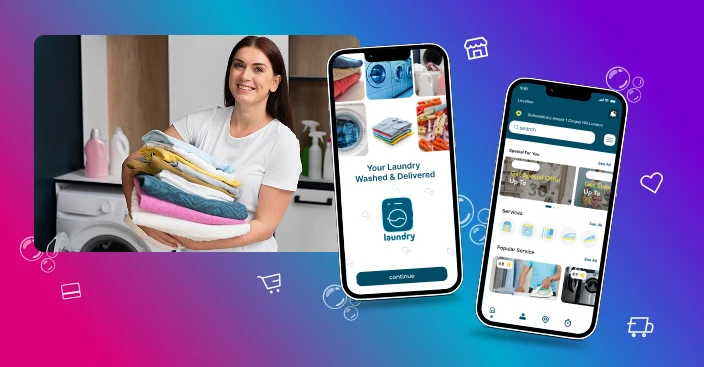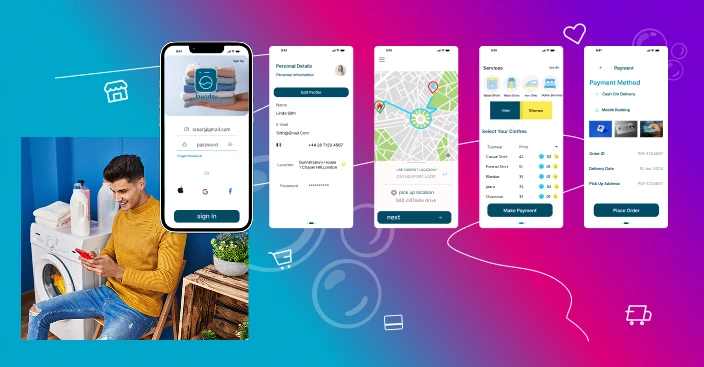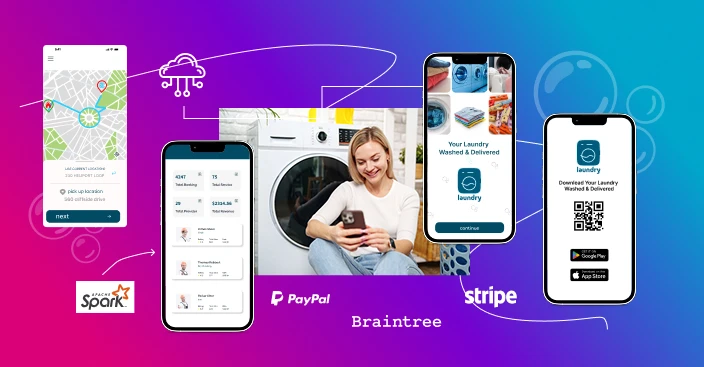Complete Guide for Building On-demand Laundry App And Necessary Features

Imagine having an already packed work schedule and then having to think about going back home and completing the household chores, especially laundry. With the perfect application to take care of your laundry chores, you can now spend some quality time with your family and friends instead!
The on-demand economy continues to boom in 2025, with more than 30 million active users in the U.S. alone and global spending projected to surpass $160 billion by 2026, according to Grand View Research.
Among these, the laundry and dry-cleaning market is also witnessing steady growth, driven by urbanization, dual-income households, and consumer preference for convenience.
According to recent market data from Statista (2025), the global Laundry Care segment is projected to reach over $105 billion by the end of 2026, with a CAGR of 3.2% from 2023 to 2026.
This growing demand presents a significant opportunity for entrepreneurs and startups looking to launch feature-rich on-demand laundry apps.
So, if you intend to establish a start-up for laundry services or operate a dry cleaning business, then this blog is your ultimate laundry app development guide.
Understanding the On-Demand Mobile App Development Process:
In this segment, we shall discuss how you should go about the mobile app development process that is targeted towards the provision of efficient laundry services.
Before we delve into the features that will make your app fulfil the customer’s demands and yet help you to stand out amidst the competition, let us understand how the interface works.
How does a customized laundry app work?
Mostly there are three stakeholders in the on-demand laundry app – the admin team/ the laundryman, the customer and the pick-up/ delivery person. With a few tweaks to the system, the laundry app services can be automated with the development of a customized mobile laundry app.
The mobile app that is developed should be compatible with iOS and Android devices and should be available for download on the app store. Once downloaded, here’s how the app works:
- The users get themselves registered and log into their accounts
- Users can generate requests for laundry services based on their requirements.
- The requests are received by the admin team who checks the feasibility of the specified schedule
- The admin team accepts the order if the slot is available
- A confirmation e-mail and message is sent to the customer
- If an opening is unavailable, the system sends a text message and an e-mail informing the customer of the same with suggestions for an alternative slot
- Once the order is confirmed, the user is contacted by a pick-up person who coordinates with the customer
- On the requested date, the pick-up person collects the clothes and takes them to the laundry
- After cleaning and pressing, the garments are delivered back to the customer
Important Laundry App Features:
To create an application that can cater to the demands of the stakeholders in the business, we can divide the features of the apps based on the functionalities it provides to each user, namely:
- The Customer
- The Laundry Man/ Admin
- The Delivery Man
Let us understand each of these features separately:
Features that cater to the needs of the customer on the on-demand laundry mobile app:
- Hassle-free login and sign up process:
This feature provides for better app usability by allowing customers to register on the app by using their mobile numbers, e-mail IDs or social media accounts. This attribute accounts for a faster registration process by reducing the time required to type in all the details.
- Service option selection:
Customers love options. Hence, to allow for better customization of the services provided, they can be given several options that can help them specify the kind of treatment they would choose. This feature might include defining the kind of fabric, nature of clothing, type of detergent, washing preferences, and so on.
- Scheduling delivery:
The laundry application should provide the customers with the option of scheduling their distribution according to a date and time that is convenient for them. If the app has a retail laundry business associated with it, then it can also provide the customer with the option of collecting their deliveries from one of the retail outlets.
- Scheduling pick-up:
The customers are free to choose the time of pick-up according to their convenience. To facilitate this, the customer just needs to set the date and time of pick-up from the mobile app, and it will be picked up from their doorstep.
- Estimating costs:
After the customer specifies the number of clothes as well as the services choices, they will be able to view an estimated cost of availing the specified assortment of services. The details of the price break-up according to the material or treatment specified should also be available on the app.
- Trusted laundry man:
Based on prior service availed, the customer can be provided with the option of selecting their prior laundryman, if they were happy with their prior function. This way, they can mark a laundryman as their’ most trusted’/’favourite’ based on their previous experience.
- Payment options:
The app should be equipped to provide multiple payment options to the customers while checking out in order to save time and make it more convenient for the customers. It should provide direct access to funds through the use of credit/ debit cards, net banking and different payment gateways such as PayPal, PayTM, etc.
- Order tracking in real-time:
One of the essential features that come into play after the placement of the order is the real-time tracking of the shipment. With this option, the customer can use the laundry service app to remain updated about the status, which will be updated on the app periodically by the admin team or the laundryman.
- Cancellation of Order:
Sometimes customers might face a situation where they have to cancel their orders, and hence, the mobile app should come equipped with the feature which allows them to do so. The application should be able to send the booking cancellation notification to the pick-up person as well as the admin team, thereby opening up the booked slot.
- Push notifications:
Enabling push notifications allows for customers to receive notifications about the status of the order, promotional offers, etc. Hence, it is another necessary feature for on-demand laundry applications.
- Promotional offers:
The application should come equipped with a dedicated section that displays the personalized offers that the customer can avail. This section can also include information about the loyalty points they can earn through their bookings, which can be encashed while paying for future orders.
- Customer Reviews:
After completion of the entire service process, the app should have a provision for the customers to provide their valuable feedback and ratings for both the laundry man as well as the delivery person.
- Other features:
Other features may include incorporating convenience features such as 24/7 user support and cost calculator.
Features that cater to the needs of the Laundry Man or the Admin Team on the on-demand laundry mobile app:
- Dashboard:
The app interface should provide an interactive dashboard which is accessible by the admin team. Through this dashboard, they can access the information regarding the customers and the delivery executives. The panel for the laundrymen looks a little different, providing data regarding the number of clothes, materials, timelines and so on.

- Login:
The laundrymen or the admin team will have their dashboard where they will have to register themselves and through their e-mail IDs, mobile numbers or social media accounts. Passwords and fingerprints can be integrated to enable safer and easier access to the laundry men’s accounts.
- Previous order history:
The admin department tries to provide customized app offers for retaining loyal or repeat customers. To identify these customers, the admin team strives to look at the volume and the frequency of purchases made by them. Hence this feature is essential in terms of marketing.
- Data Analytics:
The app should be able to record the real-time stats regarding all aspects of app usage, booking and delivery on a weekly, monthly or yearly basis. It should also be able to present the data comprehensively through the utilization of infographics. This helps to measure the overall performance of the app.
- Reminders:
The app should have a calendar and reminder section, which enables the admins to schedule tasks as well as send push notifications instantly. This feature helps the laundrymen to stick to the schedules with ease.
- Other features:
Other features might include sections for accepting and rejecting order requests, charge management and task assessment.
Features that cater to the needs of the Delivery/Pick-up on the on-demand laundry mobile app:
- Login:
As mentioned in the case of the laundrymen and the customers, the delivery personnel also need to register themselves on the app in the same way.
- Access to Route Map:
This is the most critical feature for the delivery personnel since they have to follow the route to reach the customer in the shortest possible amount of time. This helps to expedite the process of pick-up and delivery.
- Keeping track of earnings:
The app should provide a segment where it helps the delivery executives to count and keep track of their daily earnings.
- Pick-up and Drop request:
This provides the delivery men with a module that helps them receive requests for pick up and drop off.
Technologies used in the development of a mobile laundry app:
Selecting Programming languages according to OS:
Different app development companies use various technologies in the construction of on-demand applications based on their operating systems. For example, for Android app development, languages like Java or Kotin can be the preferred language. Whereas, iOS apps are developed by using coding languages such as Objective C and Swift.
Cloud Technology:
When it comes to the development of an on-demand service app, cloud servers play a significant role. All kinds of information regarding payment methods, customers, orders, and laundry people are stored on the cloud servers.
Presence of cloud servers adds to the scalability of the business. All communication related to the business is managed through the secured servers, which helps to ensure data security.
Database Programs:
Programmers developing the application can integrate cross-platform document-oriented database programs such as MongoDB, MySQL or MsSQL. The database that can be used is subject to change based on the requirements of the projects.
Push Notifications:
Technologies such as Firebase Cloud Messaging (FCM), OneSignal, and Twilio can be used to send SMS and notifications to app users.

GPS:
An inbuilt GPS tracking system is an indispensable feature of an on-demand service application. It provides the delivery personnel with turn-by-turn navigation in real-time. It also exhibits distance and the time for which he has to travel to reach the delivery address.
With GPS technology, it is easier to update the customer about the accurate ETA of their order.
Analytical Tools:
To facilitate the growth of any business, identifying the areas of improvement is vital. Hence, it becomes crucial to use analytical tools to analyze the statistics and generate reports on the same. These help to identify the traffic on the platform, user demographics, orders placed, deliveries completed and more.
Analytical tools such as open-source analytics tools, Apache Spark, Apache Storm, etc., can be integrated with the laundry app platform to generate reports on app usage.
Optimization:
It is crucial to focus on app optimization to ensure that your app gets downloaded off the app store. The app optimization takes care of factors such as ratings, reviews and keyword optimization, thereby increasing app visibility on the app store. This attribute leads to an increase in the volume of downloads.
Payments:
This technology forms an integral part of the app interface, thereby facilitating more convenient and faster transactions on the internet. With payment gateways like PayPal, Braintree, Stripe and many more, transactions can be completed very safely and with the click of a button.
Strategic and Financial Factors Related to Developing On-Demand Laundry apps:
To consider the feasibility of operating an on-demand laundry app, we have to look at the number of factors:
- The business model behind the operation of the application
- The costs involved in developing the app
- The different channels through which revenues can are earned
Business Models for the Development of On-Demand Mobile Applications
Usually, the companies that are operational in the on-demand laundry market operate through one of the two business models mentioned below:
- On-Site Model:
This model is most suited for businesses which have some physical presence and are looking forward to expanding their businesses. These businesses would ideally want to invest in a mobile application to streamline the process of taking orders and also to reach out to more customers.
This type of business model usually allows in-store pick-up services apart from the regular pick-up and delivery services. Their charges are relatively reasonable.
- Aggregator or Marketplace Model:
This model is mostly intended for start-ups which do not have their laundry businesses or equipment. Thus, they create a marketplace for different laundry service providers to come together and reach out to the customers through a unified platform.
This model saves the laundry business owners the additional hassle of developing an app or a website. They need to only pay a nominal listing fee to get registered on the application. A particular portion of their profits per order goes to the application developers.
The transactions are handled by the marketplace operators. In some businesses, the marketplace operators have also been involved in the provision of order pick up and delivery services to the laundry operators.
This model benefits the users since it saves them from the additional hassle of downloading too many applications.
In 2025, laundry apps are also beginning to integrate AI-powered personalization, eco-friendly options, and dynamic pricing algorithms to attract sustainability-conscious users and improve user retention.
These value-added services also open up new revenue streams like premium green cleaning packages or smart recommendations for repeat orders. They can compare prices and opt for different laundry operators at different times.
Cost Factors for building a mobile laundry application:
The cost of producing any on-demand application platform depends on several factors. These factors include:
- Development platform
- Design Standards
- Complexity
Since on-demand laundry apps fall into the same category, let’s understand what governs the above cost factors.
- Platform Selection:
Some applications require more time to be tested than others. For example, an Android app will take a more considerable amount of time for construction than an app meant for iOS. This is because the number and types of devices using the Android platform is higher than that of iOS.
An increase in the time of testing and development has an impact on the app development cost, which also increases.
Some platforms, such as Iconic and Fluttr, provide solutions for building cross-platform laundry apps at a cheaper cost.
- Design Standards:
The customer using any kind of on-demand application will have a specific set of requirements that he would want to be fulfilled. It is essential to be aware of such design standards and take them into consideration while constructing the laundry app.
- App Complexity:
The complexity of any on-demand application is dependent on the number of features it tries to incorporate in the app platform. If it’s a simple application with only the essential elements, it will take less time to develop as compared to an app that consists of more features.
Cost of building a mobile laundry app:
Now, let us take a look at the estimated number of hours consumed at each stage:
- Development hours for an Android app: approx. 800$
- Development hours for an iOS app: approx. 750$
- Designing hours required for iOS/ Android apps: 140-200$
- Admin panel development hours: 60$
- Backend development hours: up to 200$
This accounts for approximately 1000 hours. In 2025, with the adoption of low-code tools, AI-powered backend builders, and automated testing frameworks, some companies can reduce development time by up to 20–25%, depending on the complexity of features like real-time tracking or dynamic pricing.
Now, the costs associated may also vary with the geographic location of the laundry app development company, since the hourly rates of their app developers vary according to their sites.
- US App Developer: $100 to $250 per hour
- East European App Developers: $50 to $150 per hour
- Indian App Developers: $15 to $80 per hour
Multiplying the aforementioned hourly rates to the total number of hours required for the development of the applications, we get the total cost. In this case, we observe the average price of developing a laundry app meant for a single platform would range between $12000 to $30000.
Revenue Model used for the development of an on-demand laundry application for mobiles:
There are several channels through which an online laundry business can draw in its revenues. This is unlike the regular brick-and-mortar laundry businesses that can generate revenues only from one stream.
The ways through which online laundry businesses can generate revenue can be broken down into the following heads:
- Through the provision of essential laundry services:
This would be the primary source of income for the firm, by charging the customers for the service they have opted for.
- Differential pricing, according to the material chosen:
Different materials can be charged differently based on the amount of care that needs to be taken. This generates added revenues through selective pricing.
- Providing a subscription scheme:
Through this model, customers can be charged an extra fee for a subscription. This can include privileges such as one-day delivery, offers on bulk orders, and more.
- Charges for listing:
If your laundry business is of the aggregator type, then a possible revenue stream can be to charge the laundry services for being listed on the mobile application.
Conclusion
An on-demand application is the future of the services industry, where different services are available at the user’s fingertips. With the success of the on-demand video, transportation, and food delivery applications, it is easy to understand that the market for on-demand applications is bound to expand.
The development costs of these applications are easily covered by the utility that the customer gains from them. Through the amount of convenience they bring to the customers, the apps are sure to generate revenue during the early stages of their introduction.
The most important reason for entering the on-demand mobile laundry app market would be that it creates an online presence of the company. This, in turn, provides more credibility to the users and
also helps to establish a brand name. This brand name eventually helps to promote the business, both online as well as offline.
Moreover, the on-demand laundry application market is still an unexplored market that is not saturated by too many market players.
Hence, an early entry will guarantee visibility that is bound to propagate the business further and ensure a competitive edge above the other companies. Connect with an On-demand laundry app development experts for better understanding and implementation.





